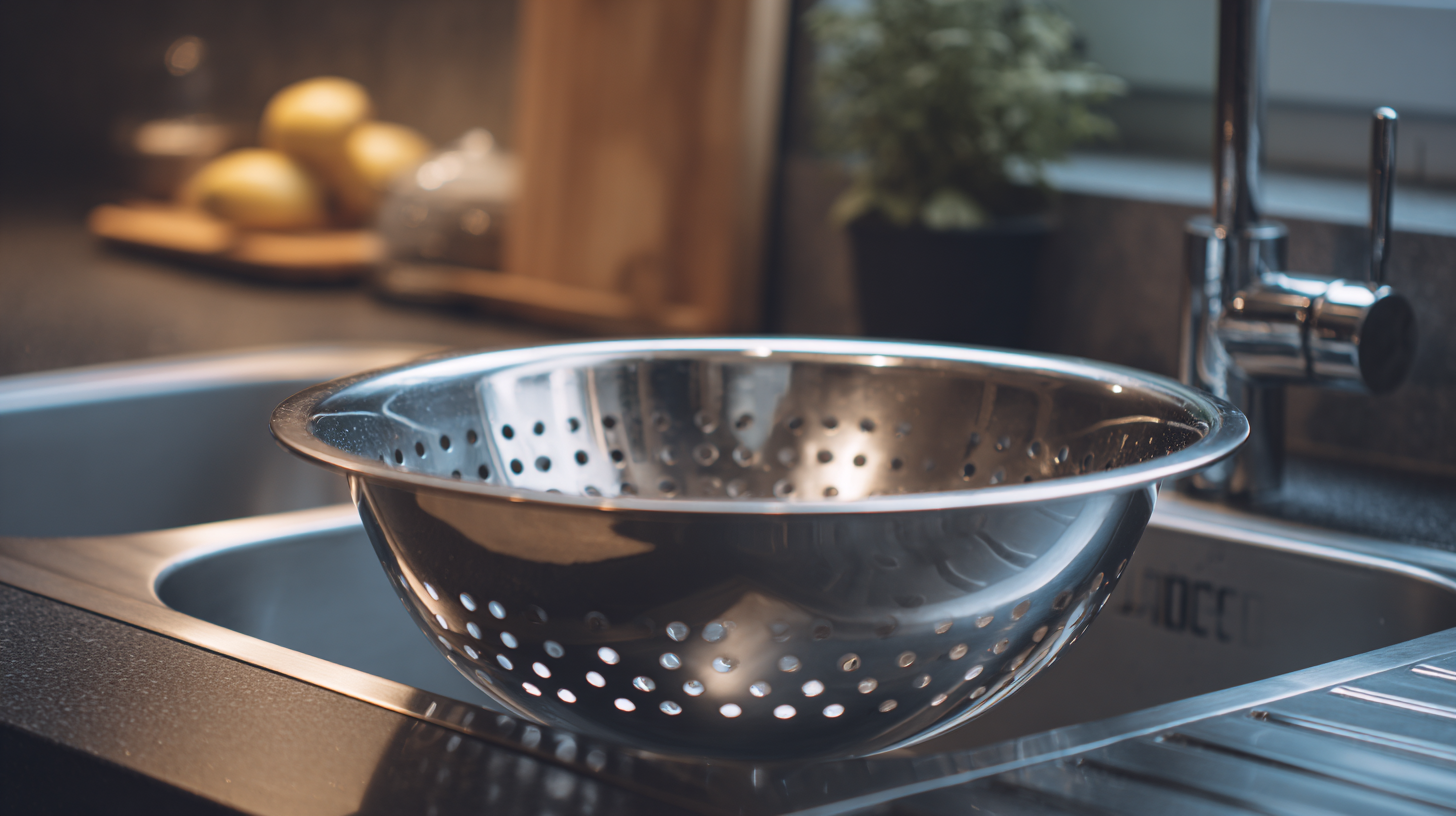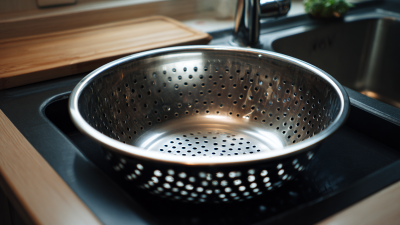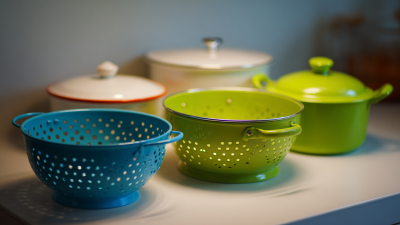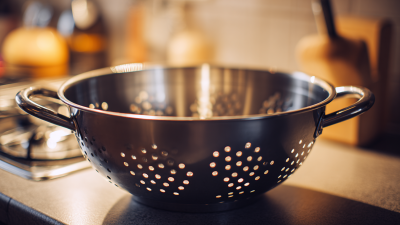Welcome to this website!

In the busy environment of a modern kitchen, having the right tools at hand can significantly enhance efficiency and convenience. One essential accessory that often gets overlooked is the "Sink Colander." According to a recent industry report by the Home Improvement Research Institute, approximately 75% of households now prioritize multifunctional kitchen tools that maximize space and usability. A quality sink colander not only facilitates food preparation but also contributes to a more organized workflow, minimizing clutter and optimizing cleaning processes. With a wide variety of options available, from collapsible designs to specialized strainers for different food types, choosing the perfect sink colander tailored to your kitchen needs can elevate your culinary experience. This guide will explore the key features, materials, and sizes to help you make an informed decision, ensuring that your kitchen remains both stylish and functional.

When selecting the perfect sink colander, understanding the different types available is crucial for meeting your kitchen needs. Sink colanders come in various materials, such as stainless steel, plastic, and silicone. Stainless steel colanders are highly durable and resistant to rust, making them a long-lasting choice. They are ideal for heavy-duty tasks like draining pasta or washing large quantities of vegetables. Plastic colanders, while lightweight and typically more affordable, are best suited for lighter tasks. However, they may not withstand high temperatures compared to their stainless steel counterparts. Silicone colanders offer flexibility and easy storage; they can be collapsed for convenience, making them a great option for smaller kitchens.
Size is another important factor to consider when choosing a sink colander. Colanders come in different dimensions to fit various sink sizes. A larger colander can handle bigger tasks, such as rinsing a whole batch of greens or draining water from larger pots. Conversely, a smaller colander is perfect for quick tasks and can easily be stored without taking up much space. Additionally, the design of the colander can influence its functionality. Colanders with handles allow for easy lifting and transferring, while those with built-in features, like a spout, facilitate easier pouring. Ultimately, understanding these aspects will help you choose a sink colander that not only fits your kitchen but also enhances your food preparation experience.

When selecting the ideal sink colander for your kitchen, it's essential to focus on key features that ensure practicality and longevity. Drainage capability is paramount; a colander should efficiently allow water to escape while retaining food items. According to a market research report by Statista, over 70% of consumers prioritize drainage efficiency when purchasing kitchen utensils, suggesting that a well-designed colander can significantly enhance the cooking and cleaning experience.
Durability is another critical factor. High-quality materials like stainless steel or BPA-free plastic not only provide resistance to wear and tear but also ensure that the colander can withstand temperature variations. A recent survey by the Kitchenware Product Association noted that 65% of users replaced their colanders due to material degradation after just one year of use. Hence, investing in a robust sink colander can save money and reduce waste over time.
Lastly, ease of use cannot be overlooked. Features such as ergonomic handles, non-slip bases, and lightweight designs contribute to the overall user experience. Research shows that products designed with user-friendliness in mind see 30% higher customer satisfaction rates. Therefore, when choosing a sink colander, consider these essential features to ensure it meets your kitchen needs effectively.
When selecting a sink colander that perfectly fits your kitchen, accurate measurement of your sink is crucial. Start by measuring the width of your sink basin, which typically ranges from 22 to 30 inches for standard models. Use a flexible measuring tape to gauge the length diagonally from one side of the sink to the other. This step ensures that the colander won't be too small or too large for your setup, allowing for optimal drainage and waste disposal.
Next, consider the depth of your sink, as this can significantly impact colander compatibility. Measure from the top edge of the sink to the bottom, and take note of any protruding features such as a drain. Additionally, note the shape of your sink—whether it's a single basin or double basin—as this will dictate the type of colander that's suitable. By combining these dimensions with the intended use of the colander, you can confidently choose a design tailored to your kitchen requirements, enhancing both functionality and aesthetics.
When it comes to choosing a sink colander, the material can significantly impact functionality and durability. Stainless steel colanders are often favored for their robustness and resistance to rust and staining. They offer a sleek aesthetic that can complement modern kitchen designs while providing superior drainage with their fine perforations. Additionally, stainless steel is dishwasher-safe, making it easier to clean and maintain. However, they can be heavier and more expensive than their plastic counterparts, which might deter some users looking for an economical option.

On the other hand, plastic colanders are lightweight, versatile, and typically more budget-friendly. They come in various colors and designs, allowing for greater personalization in kitchen décor. While plastic colanders are durable, they may not withstand heat as well as stainless steel, and could warp or discolor over time. Certain high-quality plastics can mitigate these issues, but consumers must be cautious when selecting to ensure they are getting a reliable product. Ultimately, the choice between stainless steel and plastic colanders should be based on individual kitchen needs, including aesthetics, durability, and ease of care.
When it comes to selecting the perfect sink colander for your kitchen, understanding consumer ratings and reviews is essential. Top brands like OXO, Prepworks, and KitchenAid consistently receive high marks for durability and functionality. OXO's Good Grips line, for example, is praised for its comfortable handles and non-slip design, making it a reliable choice for daily use. Prepworks, on the other hand, offers colanders with innovative features like integrated measuring units, which add versatility to your cooking routine.
When choosing a sink colander, consider a few tips to ensure you make the best decision. First, think about the size and shape of your sink. A colander that fits snugly within your sink will provide better stability and prevent spills. Additionally, look for materials that are rust-resistant and easy to clean, such as stainless steel or BPA-free plastic. Lastly, read through customer reviews to gauge real-world performance and whether the model meets your specific needs, as many users share valuable insights about long-term use and maintenance.
Ultimately, taking the time to compare top-rated sink colanders will help you find a product that not only meets your kitchen needs but also enhances your overall cooking experience.
| Model | Material | Size (inches) | Rating (out of 5) | Price ($) |
|---|---|---|---|---|
| Stainless Steel Colander A | Stainless Steel | 12 x 16 | 4.5 | 25.99 |
| Silicone Colander B | Silicone | 10 x 14 | 4.7 | 15.50 |
| Plastic Colander C | Plastic | 8 x 12 | 4.0 | 8.99 |
| Collapsible Colander D | Silicone/Plastic | 11 x 15 (collapsible) | 4.6 | 19.99 |
| Mesh Colander E | Stainless Steel Mesh | 14 x 16 | 4.8 | 30.00 |






